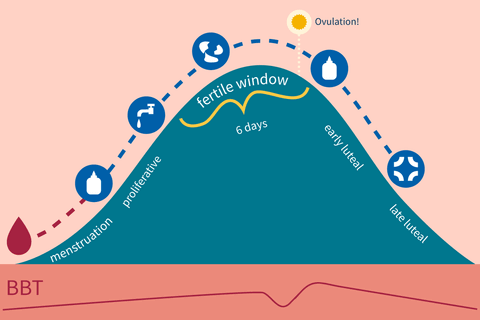The better you understand your unique menstrual cycle, the better you can understand your fertility.
Although the average menstrual cycle length is 28 days, a cycle can actually be a few days longer or shorter and still be considered regular. Cycle length can also vary a little from cycle to cycle and still be considered regular.
The menstrual cycle, which begins and ends with the day a period starts, is broken down into four phases. Each phase is signaled by hormonal changes in the body: menstruation (your period), and then the proliferative, ovulatory, and luteal phases.
For many people, the period is the most recognizable phase of the menstrual cycle. And this is with good reason - after all, it does involve some rather obvious symptoms like bleeding and cramps.
But unfortunately, sometimes this means that people don’t know much about the happenings and importance of the others phases of their cycle. The roles that the proliferative, ovulatory, and luteal phases play in your fertility and general health are just as important as the menstrual phase!

What are the phases?
The body performs different functions throughout the four phases of the menstrual cycle, each of which plays a unique role in the reproductive process:
Proliferative: The proliferative phase is the stage of the menstrual cycle in which ovarian follicles - structures in the ovary that each contain a single egg - mature and prime themselves for ovulation.
Many hormones perform different functions all geared toward the goal of producing an egg for fertilization once the ovulatory phase starts, usually around two weeks after the cycle begins. Although many follicles start maturing during the proliferative phase, usually only one eventually proves dominant, and becomes the sole egg available during ovulation.
Ovulatory: The ovulatory phase begins as a hormone surge forces the dominant egg to break free from its follicle and nest in a fallopian tube, where it will disintegrate if not fertilized within about 24-36 hours.
Ovulation is the only phase in which a person can get pregnant during their menstrual cycle. But because sperm can live for up to five days in the reproductive system, if sperm is present in the short time leading up to ovulation, this can also result in conception.
Luteal: Following ovulation, the follicle that released the egg is transformed into a corpus luteum, a structure that produces the pregnancy hormone progesterone, which thickens the lining of the uterus in preparation for a fertilized egg to make its home there for the next nine months.
If conception occurs, the corpus luteum continues to produce progesterone to maintain a healthy pregnancy. If the egg is not fertilized, the corpus luteum ceases its progesterone production after about two weeks. This drop in progesterone signals menstruation to begin.
Menstruation: The onset of menstruation is considered to be the start and end of a menstrual cycle, as it signifies the end of an opportunity for fertilization for one egg (and the beginning for millions more).
Menstruation is triggered when the corpus luteum of the last cycle’s unfertilized egg ceases to produce progesterone, usually occurring about two weeks after ovulation, causing the uterine lining to shed, along with a bit of blood.
The length and intensity of a period varies from person to person and cycle to cycle, but usually lasts between 4-6 days. Once the period stops, the proliferative phase begins again, starting the reproductive process anew.



